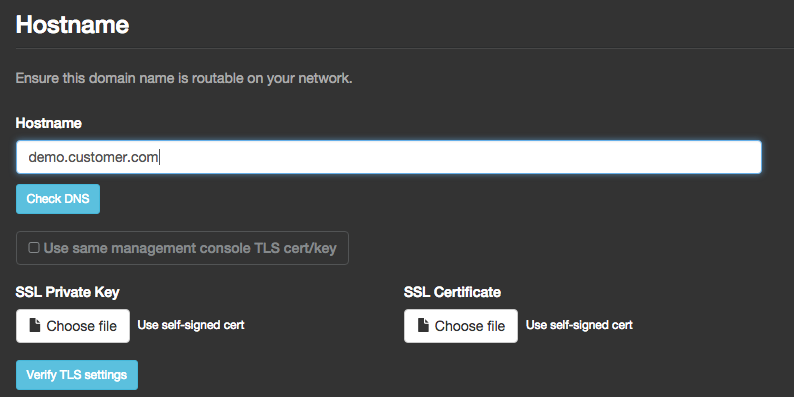Most customers will set up a subdomain & DNS for their instance of your application. During
setup you can allow them to identify their hostname and provide custom SSL certs for their
instance (as shown below). The YAML below will allow the user to determine if they’d like
to proceed with the SSL certs provided during the initial setup of the management console,
provide their own, or use self-signed certs that are generated with the cmd in the cmds
section. The YAML also writes the active file to the nginx container as a customer file.
for these fields (and ‘test’ buttons for testing
hostname resolution
& cert verification
is also provided below.

# The meta-data about your application
replicated_api_version: 1.3.0
properties:
app_url: http://{{repl ConfigOption "hostname" }}
console_title: Flask App
# Setting's screen markup
config:
- name: hostname
title: Hostname
description: Ensure this domain name is routable on your network.
items:
- name: hostname
title: Hostname
value: '{{repl ConsoleSetting "tls.hostname"}}'
type: text
test_proc:
display_name: Check DNS
command: resolve_host
arg_fields: []
- name: mgmt_certs
type: bool
title: Use same management console TLS cert/key
default: "1"
- name: override_certs
when: mgmt_certs=0
test_proc:
display_name: Verify TLS settings
command: certificate_verify
timeout: 5
arg_fields:
- ssl_cert_file
- ssl_key_file
- hostname
items:
- name: ssl_key_file
title: SSL Private Key
when: mgmt_certs=0
value: Use self-signed cert
data_cmd:
name: ssl_cert
value_at: 0
type: file
affix: left
- name: ssl_cert_file
title: SSL Certificate
when: mgmt_certs=0
value: Use self-signed cert
data_cmd:
name: ssl_cert
value_at: 1
type: file
affix: right
#
# This section uses a flask image from google and nginx image to create a hello world website.
#
components:
- name: webserver
containers:
- source: public
image_name: google/python-hello
version: latest
ports:
- private_port: "8080"
public_port: "8080"
port_type: tcp
- name: loadbalancer
containers:
- source: public
image_name: nginx
version: latest
ports:
- private_port: "443"
public_port: "443"
port_type: tcp
- private_port: "80"
public_port: "80"
port_type: tcp
config_files:
- filename: /opt/certs/server.key
contents: '{{repl if ConfigOptionEquals "mgmt_certs" "0" }}{{repl ConfigOptionData "ssl_key_file"}}{{repl else}}{{repl ConsoleSetting "tls.key.data"}}{{repl end}}'
- filename: /opt/certs/server.cert
contents: '{{repl if ConfigOptionEquals "mgmt_certs" "0" }}{{repl ConfigOptionData "ssl_cert_file"}}{{repl else}}{{repl ConsoleSetting "tls.cert.data"}}{{repl end}}'
- filename: /etc/nginx/conf.d/default.conf
contents: |
upstream web-server {
# Replace this line with your webserver
server {{repl NodePrivateIPAddress "webserver" "google/python-hello"}}:8080 fail_timeout=0;
}
server {
listen 0.0.0.0:80;
return 301 https://$host$request_uri;
}
server {
listen 0.0.0.0:443;
server_name {{repl ConfigOption "hostname" }};
ssl on;
ssl_certificate /opt/certs/server.cert;
ssl_certificate_key /opt/certs/server.key;
location / {
proxy_set_header Host $host;
proxy_set_header X-Real-IP $remote_addr;
proxy_set_header X-Forwarded-For $proxy_add_x_forwarded_for;
proxy_set_header X-Forwarded-Proto $scheme;
proxy_pass http://web-server;
}
}
#
# This cmd is used to generate the cert & key.
#
cmds:
- name: ssl_cert
cmd: cert
args:
- "2048"